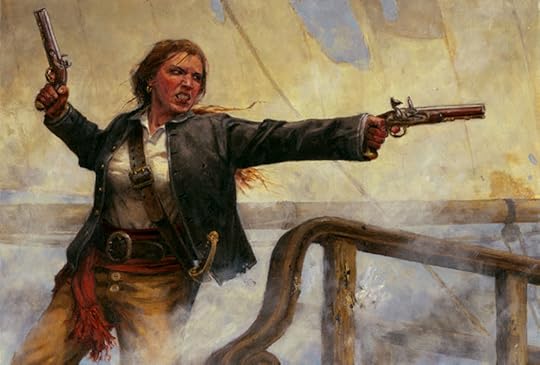Bathroom Readers' Institute's Blog, page 76
September 22, 2016
Movies You’ll Never See
From the birth of cinema in the 1890s until the late 1940s, the standard film stock was made of a nitrate base, which is highly combustible. Plus, it disintegrates quickly if it’s not stored in a special low-oxygen, low-humidity, climate-controlled vault. Result: Hundreds of films are gone forever, including these.
The Fairylogue and Radio-Plays (1908)
The first-ever adaptation of L. Frank Baum’s Oz books, it starred Baum interacting with drawings of his characters. The single print was in Baum’s possession, but it disintegrated and was thrown out by his heirs.
The Werewolf (1913)
The first werewolf film was lost in a 1924 fire.
Cleopatra (1917)
It starred silent-film icon Theda Bara in the title role and had a huge (at the time) budget of $500,000. All but 45 seconds were destroyed in a Fox Studios vault fire.
The Gulf Between (1917)
The first full-length color film made in the United States. Only a few frames are left.
El Apostol (1917)
Made in Argentina by Italian filmmaker Quirino Cristiani, this was the first-ever full-length animated movie. All copies were destroyed in a fire in 1926. Cristiani’s other major work was Peludópolis (1931), the first animated feature with sound. All copies of that movie were lost in a 1961 fire.
Humor Risk (1921)
The first Marx brothers movie. Harpo plays a detective chasing Groucho. It had a single screening, the audience hated it, and the Marx brothers themselves destroyed the only print.
The Great Gatsby (1926)
Only a trailer remains of the first film version of the classic novel.
Hats Off (1927)
Laurel and Hardy’s first hit. There was only one print, and it was misplaced after the movie’s theatrical run.
The Way of All Flesh (1927)
Emil Jennings won the first Oscar for Best Actor, but only five minutes of footage remains. It’s the only Academy Award–winning performance that has been lost.
King Kong Appears in Edo (1938)
One of the first Japanese “giant monster” movies, it was destroyed during World War II (not by Godzilla).
The post Movies You’ll Never See appeared first on Trivia Books and Facts | Uncle John's Bathroom Reader.
September 20, 2016
Have a Seat on the Golden Throne
We at the Bathroom Readers’ Institute already think the toilet is a work of art unto itself. At long last, the prestigious Guggenheim Museum agrees with us. Presenting the solid gold toilet.
Last week, the prestigious Guggenheim in New York City, one of the most famous museums in the world, cleared all the exhibits from its fourth-floor rotunda. All that remained was a small, single-stall restroom. And in that room was the only piece of art on the whole floor: a solid gold toilet.
Italian artist Maurizio Cattelan is behind the project, which is an exact replica of the regular porcelain toilets found in other restrooms at the Guggenheim. In fact, he asked the museum to send him two of theirs to work from. They did, and he sent back to them this 18-karat gold toilet, cast in just a few pieces and then welded together. (The Guggenheim then hired a local plumber to carefully install the throne.) The only thing on the toilet (estimated value: $2 million) that isn’t gold is the flush handle. It’s brass, but plated in gold so the color would match.
A true landmark in “interactive art,” the toilet is fully functional. Guggenheim guests are happily waiting upwards of an hour for their chance to engage with the toilet. Only one guest at a time may see or use the toilet, and they have to leave their bags outside while they do. A security guard stands outside the gold toilet at all times, and after each guests performs a brief security check to make sure no part of the toilet has been stolen or vandalized.
Janitorial staff sweeps in to clean the toilet every 15 minutes. But they can’t use the stuff they use to clean the Guggenheim’s other toilets. Instead, the staff uses special cleaning wipes from which hydrogen peroxide has been removed—that cleaning agent would destroy the gold finish. Steam cleanings will be performed on the toilet periodically, after the museum is closed for the day.
The toilet/exhibit actually has a name: “America.” Some kind of comment on American excess, or a swipe at the wealthy? Not according to Cattelan. He thinks his solid gold toilet is quite populist. He told one reporter that it’s “100 percent art for the 99 percent.”
The post Have a Seat on the Golden Throne appeared first on Trivia Books and Facts | Uncle John's Bathroom Reader.
September 19, 2016
Buccaneer Babe – Story of a Female Pirate
If pirating separated the men from the boys, how come one of the best pirates was a woman? Here’s the story of Anne Bonny. Story first published in Uncle John’s Plunges into History .
Pirate Benjamin
If ever there was an old boys’ club it was under the Jolly Roger. Pirating was a man’s world, and most buccaneers wouldn’t let women on board unless they were captives. But some ladies managed to become pirates and beat the men at the plundering game. The woman pirate most famous for her fierceness and temper was Anne Bonny. Born Anne O’Malley, she was the heiress to a fortune. She could have lived a spoiled, genteel life as the belle of a Southern plantation, but she threw it all away for a cutlass and a pair of breeches (that’s pants, to you).
Who She Was
She was born in Ireland, the illegitimate daughter of a lawyer and his serving maid. Her father pretended that she was a child of one of his relatives. Eventually he left his wife for Anne’s mother and took the new family to South Carolina. Daddy got rich in America, and Anne found herself living a life of luxury.
Everything changed when her father made the mistake of objecting to her choice of husband. James Bonny was a seafaring man who was later described as “not worth a groat,” old-fashioned talk for saying he was pretty much worthless. Rather than submit to her father’s wishes, Anne eloped with James to the Bahamas.
From Lady to Pirate
Most stories depict James Bonny as spinelessly unworthy of Anne. Whatever the reason, Anne soon rebelled and left home again, this time with a handsome, freespending man, a pirate named Calico Jack Rackham. Anne and Calico Jack became part of the early eighteenth-century Caribbean piracy boom. Anne’s temper and courage were legendary. A man had once attacked her, and she “beat him so, that he lay ill of it a considerable time.”
Pirate Fashions
Anne “wore men’s cloaths” into battle, but most other times she wore “women’s cloaths.” Her battle outfit was a man’s jacket, long “trouzers,” a handkerchief tied around her head, a pistol in one hand and a machete in the other.
Anne Shows Her Stuff
In 1720 the British, determined to put an end to piracy in their Caribbean colonies, chased down Calico Jack. When the British boarded the ship, only three pirates stayed on deck and fought. One of them was Anne. The rest of the pirates, including Calico Jack, holed up belowdecks. The British captured Calico Jack and his crew and took them to prison. Just before he was to be hanged, Calico Jack was granted leave to visit Anne in prison. If he hoped for any last-minute tenderness, he was disappointed. Anne told him bluntly that she was sorry, “but if he had fought like a man he need not have been hang’d like a dog.” Anne had proved her mettle in her last days at sea.
Her Last Days
Anne would have swung beside her lover, but she “pleaded her belly,” old-fashioned talk for “I’m pregnant.” She didn’t hang, and there’s no record of what did happen to her. Some say her wealthy father secretly arranged her release. Others are sure that clever, feisty Anne saved herself somehow.
The post Buccaneer Babe – Story of a Female Pirate appeared first on Trivia Books and Facts | Uncle John's Bathroom Reader.
September 16, 2016
Famous People’s Pets
Do you think an animal cares that its owner is a celebrity? Probably not…but we do.
MADONNA has a Chihuahua named Chiquita.
ERNEST HEMINGWAY had Springer Spaniels named Black Dog and Negrita (and 30 cats).
LEONARDO DICAPRIO has a Poodle named Rufus and a lizard named Blizzard.
MARTHA STEWART has cats named Beethoven, Mozart, Vivaldi, Verdi, Teeny, and Weeny.
VIRGINIA WOOLF had a marmoset named Mitz.
ADOLF HITLER had a German Shepherd named Blondi.
JESSICA SIMPSON has a pot-bellied pig named Brutus.
MICHAEL JACKSON had a llama named Louie.
CALVIN COOLIDGE had raccoons named Rebecca and Horace.
MUHAMMAD ALI had a tabby cat named Icarus.
CAMERON DIAZ has a cat named Little Man.
GEORGE CLOONEY has a pot-bellied pig named Max.
SIGMUND FREUD had a Chow named Jo-fi.
DREW BARRYMORE has a Lab/Chow mix named Flossie.
TRUMAN CAPOTE had a Bulldog named Bunky.
SYLVESTER STALLONE has a Boxer named Gangster.
BRITNEY SPEARS has a Yorkshire Terrier named Baby.
SLASH has a Golden Retriever named Belle.
GEORGE ORWELL had a dog named Marx and a goat named Muriel.
CHRISTINA AGUILERA has a dog named Jackson (for her idol, Michael Jackson).
CHARLES DARWIN had a dog named Bob.
The post Famous People’s Pets appeared first on Trivia Books and Facts | Uncle John's Bathroom Reader.
September 15, 2016
When Black Metal Met the City Council
Norway is the ancestral home of some of the darkest, loudest, and most frightening music in the world: black metal. (It’s way heavier than regular heavy metal.) That contingent of the Norwegian population is finally being represented in the political sphere…even if it doesn’t want to be.
 The musician known only as “Fenriz” is a major figure in black metal. As half of the Norwegian duo Darkthrone, he’s mostly a drummer, but he’s also played guitar and sang for the band. Darkthrone has released more than a dozen albums, all of which have totally metal titles like Sardonic Wrath, Ravishing Grimness, Total Death, Under a Funeral Moon, and the forthcoming Arctic Thunder. Fenriz doesn’t live in a dungeon or on top of a mountain one would think a Norwegian metal star would reside. Nope: He has a home in Kolbotn, a quiet town of about 9,000 people just outside the Norwegian capital city of Oslo.
The musician known only as “Fenriz” is a major figure in black metal. As half of the Norwegian duo Darkthrone, he’s mostly a drummer, but he’s also played guitar and sang for the band. Darkthrone has released more than a dozen albums, all of which have totally metal titles like Sardonic Wrath, Ravishing Grimness, Total Death, Under a Funeral Moon, and the forthcoming Arctic Thunder. Fenriz doesn’t live in a dungeon or on top of a mountain one would think a Norwegian metal star would reside. Nope: He has a home in Kolbotn, a quiet town of about 9,000 people just outside the Norwegian capital city of Oslo.
Earlier this year, political organizers in Kolbotn called Fenriz to ask if he’d be willing to put his name on a list of backup candidates for city council. Fenriz thought that this meant that he’d be a last minute backup should one of the real candidates drop out at the last minute. So, Fenriz allowed his name on the list (just because you’re metal doesn’t mean you can’t fulfill your civic duty). He didn’t think anything would come of it: “I said yeah, thinking I would be like 18th on the list and I wouldn’t really have to do anything.”
But Fenriz wasn’t a backup candidate—his name wound up on the ballot as a candidate to be a backup. This means that those in Kolbotn who checked his name on their ballot were voting for him to be an official backup councilman should some other city council member not be able to attend a meeting. So just to make sure that he didn’t get elected to that position, Fenriz did some anti-campaigning: He released a photo of himself, holding his cat, Peanut Butter, along with the message asking the people of Kolbotn to not vote for him.
The picture backfired. Fenriz is a celebrity, and in his photo he was holding a cat. Of course he wound up getting elected to the Kolbotn council as a “backup.”
“Basically, I have to step in when the usual people who go to the big meetings are sick or something. Then I have to go sit there and feel stupid,” Fenriz told reporters. Or, rather “Councilman Gylve Fenris Nagell” (his real name) told reporters.
The post When Black Metal Met the City Council appeared first on Trivia Books and Facts | Uncle John's Bathroom Reader.
September 6, 2016
The Eternal Twinkie and Other Food Myths
We at the BRI have an insatiable appetite for finding misinformation, including these food myths.
French Fries
Myth: French fries aren’t really French—they’re Belgian.
Truth: Fried, salted potato strips did originally come from Belgium (they were introduced to America by soldiers returning home from World War I). But French fries are also French. How so? The term refers to the way they’re cut—long, thin strips are called julienne, or French style.
Belgian Waffles
Myth: Belgian waffles are Belgian.
Truth: They’re American. Some enterprising food vendor in the Belgian Village pavilion at the 1964 New York World’s Fair added yeast to normal waffle batter so they’d be fluffier. To make his new creation sound more exotic, he called them “Belgian” waffles.
Pasta
Myth: The Chinese invented pasta.
Truth: Legend has it that Marco Polo discovered noodles during his travels to China and brought his discovery back to Italy. But actually, the Italians already had noodles. They’d been making them for centuries. The difference: Chinese noodles are made from rice or buckwheat. Italian pasta uses semolina flour, a type of wheat.
Twinkies
Myth: Twinkies will stay fresh forever.
Truth: True, Twinkies have a longer shelf life than most other baked goods. But that’s because they contain no dairy products, not because they’re full of preservatives. How long do they really stay fresh? According to Hostess, a mere 25 days.
Sugar
Myth: Sugar makes kids hyper.
Truth: For years scientists have conducted studies, trying to link sweets with hyperactivity…without success. A 1995 double-blind American Medical Association test concluded that there is absolutely no chemical link between sugar and behavior problems. There may be a psychological link, however: parents who expect sugar to affect their child tend to imagine the kid is misbehaving.
The post The Eternal Twinkie and Other Food Myths appeared first on Trivia Books and Facts | Uncle John's Bathroom Reader.
Ask Uncle John Anything: You Better Not Be Wearing White Today
Uncle John knows pretty much everything—and if he doesn’t, he puts one of his many researchers on the case. So go ahead: In the comments below, ask Uncle John anything. (And if we answer your question sometime, we’ll send you a free book!)
Why is it considered bad to wear white after Labor Day?
Our readers are very fashion conscious and wouldn’t want to do anything that would offend high society ladies. And nothing is more untoward or gauche than wearing white after Labor Day. But why…and does it still matter in the year 2016? No, it doesn’t matter anymore…but here’s the story of why it once did.
In the wealthy East Coast communities of the late 1800s and early 1900s wearing clean, pristine, white clothes unspoiled by hard labor in the summer months sent the message of wealth. White clothes were highly fashionable, and thus expensive, and also prevented those who wore them from burning up in the sun. For that reason, white became known as a “summer color.” But as the middle class and suburbs grew in the early 20th century, so too did the middle class’s desire to emulate the wealthy. One way they did that was wearing the unofficial uniform of the rich: white clothes. The wealthy, high society circles didn’t appreciate their thing getting co-opted by others, so a new fashion rule was established among the tight-knit East Coast elite: Keep wearing white during the summer months only, because it was functional to do so. But once Labor Day rolled around (more or less the official end of summer, which became a federal holiday in 1894), they stopped. Those who kept wearing white after early September, the reasoning went, could be quickly identified as not really wealthy, but rather imitators and pretenders.
The middle classes eventually got wind of the “don’t wear white after Labor Day” rule, with fashion magazines “breaking” the news as late as the 1950s. Some major fashion players ignored it—Coco Chanel, for example, liked to wear white year-round. But otherwise, it’s a notion that’s stuck in the public’s mind as “proper fashion” ever since.
By the way, it’s appropriate to start wearing white again on Memorial Day weekend.
The post Ask Uncle John Anything: You Better Not Be Wearing White Today appeared first on Trivia Books and Facts | Uncle John's Bathroom Reader.
September 2, 2016
Halle Berry Gets Hurt a Lot
Accidents can happen at work, even on movie sets. Or, if you’re Academy Award-winning actress Halle Berry, especially on movie sets. The actress has incurred a remarkable number of (thankfully) minor injuries during the filmmaking process.
Die Another Day
Berry portrayed Jinx, an NSA agent in this 2002 James Bond movie. While filming an action sequence, the smoke from a prop grenade flew into her eye. Along with it came a bunch of dirt and debris. Berry required a 30-minute eye operation to undue the damage of the freak accident.
Gothika
A scene in this 2003 psychological thriller called for Robert Downey, Jr.’s character to restraint an unhinged Berry. Downey got a bit too far into character and twisted Berry’s arm. He finally stopped when he heard something pop. Sure enough, Downey broke her arm. Production on Gothika was delayed for eight weeks so Berry’s arm could heal.
Catwoman
While filming a stunt sequence on the 2004 Batman spinoff, a piece from a lighting rig came lose and fell…and hit Berry on the head. She fell to the ground and walked off set. Berry went to a hospital, where she was examined and doctors discovered that somehow she hadn’t suffered a concussion. (She took a couple of days off before going back to the Catwoman set.)
The Hive
In July 2012, Berry was in Los Angeles filming a fight sequence for this drama. Then she fell and hit her head on concrete. She was rushed to an emergency room and made a full recovery.
The Call
A very similar thing happened to Berry a year later on the set of The Call. While filming a fight scene, actor Michael Eklund, accidentally dropped Berry on the ground, and her head did the concrete. She was briefly knocked unconscious, and was back at work the next day.
The post Halle Berry Gets Hurt a Lot appeared first on Trivia Books and Facts | Uncle John's Bathroom Reader.
September 1, 2016
Where Did the Neanderthals Go?
Neanderthals were a race of hominids that developed alongside early humans. They first appeared in Africa about 700,000 years ago and slowly migrated into Europe and the Middle East. They shared almost all the same genetic classifications with Homo sapiens (us), but differed in the final category, species (Homo neanderthalensis). After about 40,000 years of sharing territory with humans in Europe, the Neanderthals died out while Homo sapiens kept evolving. So why didn’t the Neanderthals survive?
Theory #1
They weren’t smart enough. It was long conventional wisdom that Neanderthals were not very intelligent, but recent findings suggest Neanderthals had bigger heads and brains than humans.
Theory #2
They weren’t skilled hunters. Not true. It turns out that Neanderthal tools were actually more efficient than those crafted by early humans. Neanderthals are also believed to have had control over fire before Homo sapiens did, and to have cooked, rather than gathered, much of their food. (They actually ate healthier than most people do today.)
Theory #3
They couldn’t communicate well. Recent studies have led some scientists to conclude that Neanderthal voices were not incoherent grunts, as once believed, but high-pitched and melodic, and that their means of communicating may have been a combination of language, pitch, and song.
Far from being the brutish creatures of cliché, Neanderthals were probably the first hominids to bury their dead (they even left flowers on the grave sites). It is true that Neanderthals and humans looked different: Neanderthals were shorter and broader, with a heavier brow. But about the same percentage of Neanderthal and human DNA includes the genetic mutation that inhibits brown pigmentation, so Neanderthals were about as likely as humans to be pale-skinned, blond, or redheaded.
Native Africans, whose ancestors never lived alongside Neanderthals in Europe, have no Neanderthal DNA in their genomes—but pretty much all other people do. So when the last of them disappeared about 25,000 years ago, it’s possible they had already assimilated into the larger human population.
Where did the Neanderthals go? Look in the mirror.
The post Where Did the Neanderthals Go? appeared first on Trivia Books and Facts | Uncle John's Bathroom Reader.
Weird and Wacky September Holidays You Ought to Celebrate
Sure, Labor Day is great—it celebrates the workin’ folks and a lot of us get the day off. But what other holidays does September offer? Plenty…if you consider these observances to be “holidays”
Sept. 1: Emma M. Nutt Day
It’s a celebration of an important woman with a fantastic name. Nutt was the first female telephone operator in the United States. She started work in Boston on this day in 1878, and did it for 33 years. (Her employer eventually started hiring only women to work as telephone operators.) The holiday is mean to acknowledge people who work in the communications industry, not just Nutt who once quipped that she was “thankful that my first name was not Imma.”
Sept. 3: International Bacon Day
Here at the BRI, we thought every day was Bacon Day (the “B” could stand for “bacon”), but apparently there’s an official day for it. Celebrated the Saturday before Labor Day, it was created in 2000 by three students from Bedford, Massachusetts, long before the “bacon craze” of the last few years. How can you celebrate? Eat some bacon! (Or turkey bacon, soy bacon, Canadian bacon…)
Sept. 16: Collect Rocks Day
It’s a definitive, simple pleasure of childhood: collecting rocks. But just because you’re a grown up doesn’t mean you can’t still have a rock collection. Today is a good day to slow down, look down, and notice pretty rocks. Then take them home and proudly display them on a shelf!
Sept. 22: Hobbit Day
According to J.R.R. Tolkien’s fantasy classics The Hobbit and The Lord of the Rings, September 22 is the birthday of the brave little Shire-dwelling hobbits Bilbo Baggins and his nephew Frodo Baggins in the equivalent of the years 1290 and 1368, respectively. The observance was created in 1978 by the American Tolkien Society as part of a weeklong celebration of Tolkien Week.
Here are some birthday wishes from Leonard Nimoy.
The post Weird and Wacky September Holidays You Ought to Celebrate appeared first on Trivia Books and Facts | Uncle John's Bathroom Reader.














